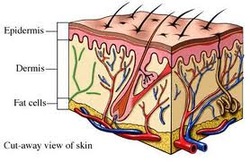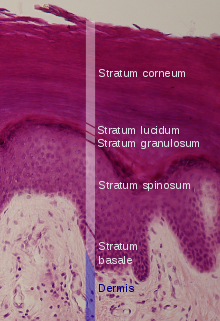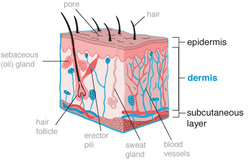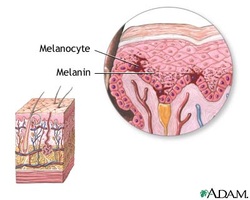The Integumentary System: Skin, Hair & Nails
The Integumentary System is a euphemism for the organ system that is your skin, hair and nails. On an adult human it weighs about eight pounds and covers 22 square feet of surface area. It protects your internal structues, like your heart, liver, kidneys etc., from the outside environment. It is what synthesises Vitamin D; when Ultraviolet light (UV light) hits the skin it causes Vitamin D systhesis to occur. In turn, your liver and kidneys produce calcitron which regulates Calcium and Phosphorous production in the body. Your skin is also a major part of your sensory reception because it is where many neurons (of the sensorry variety) are housed. These neurons are what pick up on stimuli from the external environment. Skin also aids in temperature control via sweating and evaporative cooling (when the liquid sweat evaporates off your skin it causes the skin's surface to cool).
The Layers of the Skin

Skin is divided into three major tissue sublevels:
1. The Epidermis
a. The body's first layer of defense againts invaders from the outside envrionment.
2. The Dermis
a. Where sensory neurons are found
b. Where elastic (collagenous) fibers are found
3. The Subcutaneous (Fatty) Layer
a. energy storage, insulation, protection
1. The Epidermis
a. The body's first layer of defense againts invaders from the outside envrionment.
2. The Dermis
a. Where sensory neurons are found
b. Where elastic (collagenous) fibers are found
3. The Subcutaneous (Fatty) Layer
a. energy storage, insulation, protection
1. The Epidermis & its Strata

The first layer, the Epidermis (epi meaning "on" and derm meaning "skin"), is divided into layers called strata (singular: stratum). Depending on what region of the skin there are either four or five strata. From top to bottom the layers go Stratum Corneum, Stratum Lucidum. Stratum Granulosum, Stratum Spinosum and Stratum Basale. The Stratum Corneum is made entirely of dead skin cells lacking a nuclei that are periodically shed at two week intervals. They contain the protein keratin which prevents water evaporation. The Stratum Lucidem is the next layer and is comprised of thin, translucent, dead cells. It is found only in areas where the skin is extra thick like the palms of the hands or the soles of the feet. The thickness of the lucidem is controlled by the rate of mitosis of the epidermal cells. Keritanocytes (and other things related to the production of keratin) produce keratin and are found in the Stratum Granulosum and all layers beneath it. The Stratum Spinosum, "spinous" or "prickly" layer, also prevents dehydration because it is hydrophobic. The final layer, the Stratum Basale or Germinativum, is resposible for the replacing epidermal cells. The cells of this layer are just one row of column shaped cells. Half of theses cells will move to the next layer during the maturation process. The other half stay in the layer and divide to replace them.
2. The Dermis: Hiar follicles, Sebaceous Glands & Sudoriferous Glands

Hair follices are a a part of the skin that create hair from old cells. Attached to each a follicle is a sebaceous gland. These glands emit an oil called sebum which is meant to lubricate hair. Also atteched to each hair is a small muscle called an arrector pilli. When your hair "stands on end" it is due to the contraction of this muscle. Sudoriferous, or sweat, glands produce an aqueous solution that cools the body. This solution assists in thermoregulation. All of theses things can be located within the dermis.
3. The Subcutaneous Layers
The last layer, the fatty layer, of the skin is the Subcutaneous. The fat found in this layer aids in the maintanence of homeostasis. It is mainly made of apidose, fatty, cells and some fibroblasts.
Second Helping: Melanin

Melanin is a brown pigment that creates varying shades of skin and hair. Melanocytes are melanin producing cells found in stratum basale of the epidermis. When exposed to sunlight the malnocytes produce more melanin. People from more tropical climates have darker skin because their predessors were exposed to much sunlight. over time, having darker skin became a characteristic. Conversely, people from norther climates wehre there was little sunlight have light skin. Unfortunately, people with lighter skin are much more susceptible to skin cancers because there skin just cannot protect them as adequately from UV light damage.
